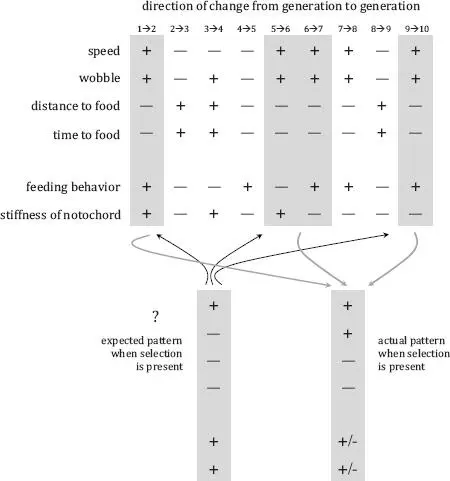Surprise! When we select for improved feeding behavior we actually make the evolutionary fitness of the Tadro3s better and worse at the same time. Tadros swim faster (and that’s good for an individual’s fitness score) but they wobble more (and that’s bad for the fitness score). To explore what was going on with this odd couple, we swam our Tadros with all their different tails in a simple swimming trial—no competition, no evolution. Just swim straight down the tank. We videotaped the Tadro3s and measured their speed and body wobble. Under these conditions speed and wobble were not correlated. In other words, in the “wild,” competing with other Tadro3s to swim and feed, speed and wobble were, for some reason, functionally connected. But in the “lab,” swimming by themselves in a straight line, Tadro3s didn’t show this functional connection.
All is revealed when we look closely at this sub-behavior that I’ve been calling body wobble. You may recall from the previous chapter that we said that wobble was a measure of how unsmooth the swimming path of the Tadro was. If you ever read Arthur Ransome’s Swallows and Amazons series as a kid, you’ll know that you can spot a novice helmsman on a small sailboat by the wiggles in the boat’s wake. Those wiggles, which come from an unsteady hand on the tiller, waste energy by rotating the boat back and forth, slowing down the boat’s forward progression. We took Ransome’s wiggles and turned them into wobbles. From videotape records, we measured the change in heading of each Tadro3 every second during the three-minute trial. We then calculated, over every two seconds, how rapidly the change in heading was occurring. If you are a sailor who navigated high school physics successfully, you may recognize this as a measure of angular acceleration in yaw. We then took all of the angular accelerations for the whole trial and calculated their standard deviation, which is a measure of how variable the angular acceleration was. This gave us a single number called wobble (in units of radians second -2).

FIGURE 4.4. For the sub-behaviors that make up feeding behavior, a consistent pattern of evolutionary change occurs when selection is present in the population of Tadro3s. For swimming speed, body wobble, average distance to the food, and time to find the food, selection, indicated by the gray background, always increases speed and wobble while decreasing distance and time. The actual pattern (bottom, right) differs from the expected pattern (bottom, left), which is based on the fitness function assigning a penalty to increased body wobble. The consistent correlation of speed and wobble under selection indicates that the two are functionally linked when Tadro3s are competing for food. When we examine the stiffness of the notochords across all generations, we find that it is statistically and positively related to swimming speed and body wobble. Stiffness is thus indirectly, not directly, correlated with feeding behavior through speed and wobble.
Check it out: wobble not only measures the rate at which the Tadro is wiggling and losing energy, what we call recoil from the flapping tail, but it also measures the presence of high-speed maneuvers. Think of it this way: a quick turn is a big, quick wiggle. We figured this out by running some digital simulations in which we would make a swimming Tadro perform a big turn quickly. We measured the resulting increase in wobble. It turns out that frequent turning maneuvers produce a huge amount of wobble, much more than the energy-wasting recoil.
We realized that wobble in the wild was picking up on all of Tadro3s quick turning maneuvers that weren’t present in the lab’s straight swimming. Cool! We had accidentally measured something different and even more interesting than what we’d intended. Now it made sense why swimming speed and wobble were positively correlated in the wild: if you are swimming faster you can turn faster. Plain and simple. Every driver and sailor knows this and slows down coming into a turn in order to maneuver smoothly or, instead, maintains their headway to make a break-neck turn.
In Tadro3s we now see that body wobble is functionally dependent on swimming speed. This gets us into a really interesting area in terms of evolutionary biology. Any trait that has a genetic basis and whose phenotypic expression is influenced by a different gene is said to be “epistatic.” [44] Warning: “epistasis” has different meanings. For example, Gillespie ( Population Genetics ) defines three different kinds of genetic epistasis. Here I am taking the broader view of interactions among genes impacting fitness, similar to “functional epistasis.” I’m interested in the gene-to-fitness mapping mediated by phenotype. In Tadro3 wobble and speed interact. Because both are correlated with stiffness, and stiffness is genetically coded, selection on wobble and speed alter the genetics of the population. Simulations show that epistatic networks can adapt: Roman Yukelevich, Joseph Lachance, Fumio Aoki, and John R. True, “Long-Term Adaptation of Epistatic Genetic Networks,” Evolution 62, no. 9 (2008): 2215–2235.
Epistasis is a very important genetic phenomenon and can occur in a variety of ways that biologists are still uncovering. With Tadro3s, though, the interaction is not conducted directly at the genetic level; we even set up the genes to make sure that they didn’t interact at the level of the genome. Instead, here we see phenotypic epistasis, a physical interaction of the sub-behavior phenotypes that occurs because the phenotypes share a single body. We established the genetic basis of speed and wobble through their connection to structural stiffness of the notochord, which is directly coded by the Tadro3s’ quantitative genes.
Now that our wobbly journey through epistatic seas is over, we can stand on terra firma when we explain the evolutionary change, under selection, from generation 5 to 6 (see Figure 4.1, again!). We had observed that this was the only time, out of four evolution-by-selection events, when selection made swimming behavior worse. We had established the fact, by looking at the changes in the proportion of genes, that random genetic effects couldn’t explain the evolutionary change. What was left to analyze was the functional relationship between the notochord’s structural stiffness, which is coded genetically, and the feeding behavior, which is judged by selection. One of the sub-behaviors, body wobble, turned out to be beneficial to improved feeding behavior, instead of detrimental, as originally thought. In addition, body wobble is functionally linked to swimming behavior.
These two final and unexpected facts about body wobble explain the also-unexpected degradation of feeding behavior from generations 5 to 6. Because the fitness function rewards increased swimming speed while penalizing increased wobble, the composite score of feeding behavior drops. Keep in mind that we measured feeding behavior using the same relationships that we used in the fitness function.
Knowing what we know now, this was a mistake. We should’ve rewarded increased wobble and called it something more appropriate, like “agility.” Unfortunately, we can’t go back and change evolutionary history without completely redoing the experiments (more on why in the following pages). We calculated the fitness function every generation in order to make the next generation. But we can recalculate the feeding behavior score with increased wobble rewarded, not penalized.
When increased wobble is rewarded, we get a slightly and importantly different picture of the evolution of the composite behavior that we call feeding of Tadro3s (Figure 4.5). First, the averages of the population’s feeding behavior now undergo more change, moving both higher and lower than their means under the old fitness-based measurement scheme. Second, one of the generation-to-generation evolutionary changes is different: from generations 5 to 6, under selection, average feeding behavior now improves rather than degrades. In other words, armed with our new understanding of wobble as a positive metric of rapid maneuvers, feeding behavior actually did improve under selection!
Читать дальше













